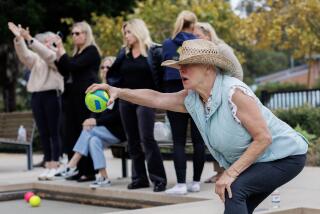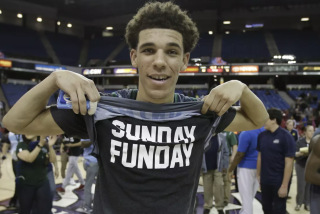Pinned to the Past : Bowling Entrepreneur’s Biggest Moment Came on Basketball Court in ’36
- Share via
He’s 50 years and 3,000 miles removed from Long Island University’s national basketball title, but Harry Grant recalls the names and faces from the championship game of 1936 as though it happened yesterday.
Grant, 73, was a guard for LIU in an era when players were fined for taking one-handed shots, there was a jump ball at midcourt after each basket, and a 5-6 guard wasn’t too small to play.
“When a player was small in those days, he had to be quick. He had to be a good ball-handler, a good passer,” said Grant, who lives in Canoga Park. “I was like a flash.”
Grant was one of several talented players on LIU’s mythical championship team--mythical because it occurred before the existence of the NCAA. The idea for a national champion began with Ned Irish, the man who later founded the Basketball Assn. of America, the forerunner to the National Basketball Assn.
Beginning in the early 1930s, Irish hired out Madison Square Garden, the old Garden on 48th Street, and invited teams from around the country to play against the New York schools: Fordham, Manhattan, St. John’s, New York University, City College of New York and LIU. In 1936, he got together with some New York sportswriters and picked LIU as the top team in the East and Duquesne as the best in the West, although the school is only as far West as Pittsburgh. Sitting in his recently closed bowling alley in Encino, Grant vividly recalled the game, which drew a crowd of 18,000. LIU had trailed by as many as seven points in the second half, but a basket by captain Jules Bender cut the Duquesne lead to 34-33 with less than a minute to play. During an LIU timeout, Coach Claire Bee gave strict orders that if LIU regained possession, the ball would go to his 5-6 guard, Harry Grant.
When play resumed, Duquesne’s big center, Joe Fortuneberry, faked a dribble past Grant, who stole the ball and, with no open shot, passed to Ken Norton. Norton took a shot from the baseline that teetered around the rim until it was tapped in by Marius Russo, who was fouled. Russo made the free throw. The clock ran out. Final score: LIU 36, Duquesne 34.
It was the 19th straight victory for LIU in a string that reached 43 over three seasons, the longest streak in college basketball at the time. The Blackbirds were finally beaten by Stanford on a cold December day in 1937, Grant’s senior year. Hank Luisetti, who revolutionized basketball with his one-handed jump shot, propelled Stanford to a 45-31 victory at the Garden.
Grant recalls those days as “the greatest time in my life.” He and his basketball-playing friends would ride the subway from LIU’s campus on Pearl Street in Brooklyn to artsy Greenwich Village or even further up to Harlem, where they’d catch a weekend vaudeville show or a play.
“We were part of a great baseball and basketball contingent that dominated the metropolitan area,” Grant said. His teammates included Norton, who later coached basketball at Manhattan College, and Russo, who went on to pitch for the New York Yankees from 1939 to 1946, winning 45 games.
Grant, the little guy who oiled the LIU offense, achieved a fame of sorts when he was featured in a 1936 issue of “Boy’s Life” magazine in a story called “The Tall and Short of It.” The article was written to show young boys that short people could succeed in sports, too.
After graduating from LIU in 1937, Grant played baseball for Clinton, a Class-C minor league team in Brooklyn, for $75 a month. On a tour through the Midwest, Clinton played the House of David, a semipro team whose members were required to wear beards. Grant, a pitcher and an outfielder, impressed the House of David coach so much that he offered him a $100-a-week contract. Grant stopped shaving from that day forward.
With the House of David, he played baseball and basketball against minor league and semipro teams. The team trained in Gulfport, Miss., and then traveled to New York and Canada, playing major and minor league clubs along the way. During basketball season, opponents included Renaissance, a Negro team, and the Boston Celtics, before they entered the NBA.
Grant’s career with House of David came to an end in 1939, when he came back to Long Island to pitch for the Jamaica Indians. As part of his $50-a-week contract with the Indians, he worked in the Jamaica Recreation Center’s bowling alley. And so began Grant’s 47-year affair with bowling.
“When I first got into the game, I noticed that all the baseball and basketball players I used to play with also bowled,” Grant said. “I always enjoyed that rapport between athletes. It’s the greatest game for all ages.”
In 1942, he packed up his bowling balls, grabbed his wife and two children and headed for Los Angeles, where he worked various bowling alleys before he made a small contribution to the sport of bowling, much like he had made his little mark in the basketball history books.
After leasing out the Cinema Sports Center, a 12-lane alley, Grant began what is now known as the Grant Classic, “a tournament that followed me for 34 years,” he said.
The tournament, which runs each year from July 12 to Nov. 30 and includes about 5,000 amateur participants, awards $58,000 in prize money, including a first prize of $10,000.
“It’s a very prestigious tournament, recognizable nationwide,” said Mel Hill, general manager of Oak Knowles bowling alley in Santa Barbara. Hill, who has entered the Grant Classic 13 times, is one of only three men to bowl a perfect game in the tournament’s 34-year history.
Even with the success of the tournament, Grant never lost his taste for the day-to-day operation. He opened the Victory Bowling Center in Van Nuys in 1953, where he met Irv Miro, who would become his partner for the next 33 years. The two men opened Encino Bowl together in 1962.
“I don’t think that any two people could have had a finer relationship,” Miro said. “I can’t think of anyone who I would put more faith and trust in.”
But, 23 years later, it’s time to close up shop.
Encino Bowl is one of five Valley lanes that have closed in the past three years because of increased real estate values. When Grant and Miro went to renegotiate with their new landlord, he told them his company planned to build a hotel.
“It was a very sad thing when the place closed,” Grant said. “We were like a family operation. We had workers for 30 years, and a lot of bowlers who bowled here felt really bad that we closed.
“But the game will survive. Bowling is a way of life. It’s as American as apple pie.”
Or, perhaps as American as basketball.
More to Read
Go beyond the scoreboard
Get the latest on L.A.'s teams in the daily Sports Report newsletter.
You may occasionally receive promotional content from the Los Angeles Times.










